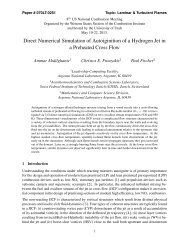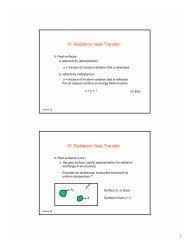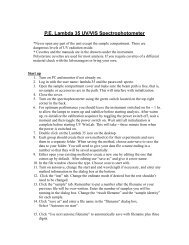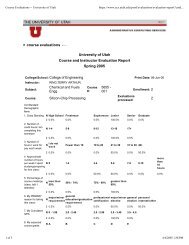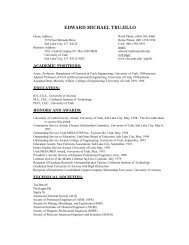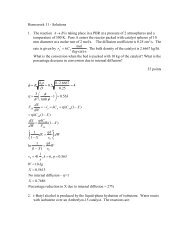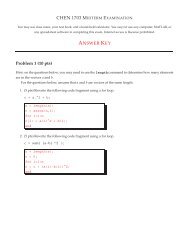Standard Operating Procedure - Ultrafiltration - Department of ...
Standard Operating Procedure - Ultrafiltration - Department of ...
Standard Operating Procedure - Ultrafiltration - Department of ...
- No tags were found...
Create successful ePaper yourself
Turn your PDF publications into a flip-book with our unique Google optimized e-Paper software.
are more difficult to degrease, to clean <strong>of</strong> fatty deposits than glass or stainless steel. The fattymolecules adhere to hydrophobic polymers stronger than to hydrophilic glass and need morechemical, physical or mechanical energy for removal. Cellulose acetate membranes are morehydrophilic and from this point <strong>of</strong> view easier to clean than the other membranes were it not forthe severe limitation <strong>of</strong> pH and temperature.An important consideration is also the viscosity <strong>of</strong> the soil or its changes <strong>of</strong> viscosity in contactwith cleaners. In membrane systems it is much more dramatic if a mistake is made in thisrespect than in most other equipment. The equipment can always be dismantled and handcleaned. One cannot do this with most membranes.A chemical reaction can occur between the soil and cleaner coagulation and precipitation <strong>of</strong>protein, for instance; polymerization and plastification in the case <strong>of</strong> the reaction <strong>of</strong> aldehydeswith peptines (polysaccharides used in jam manufacturing) by acids, etc. that can lead to serioustrouble. Laboratory studies in the case <strong>of</strong> previously unknown soil types are recommended, thecouncil <strong>of</strong> experienced personnel in membrane cleaning should be sought BEFORE fouling themembrane.MEMBRANE MATERIAL:A membrane surface is not as smooth as a microscopic scale as a polished metal surface. Underthe powerful microscope it looks like a sponge, which it is in a way. The pores <strong>of</strong> the activefiltrating layer are actually so small that even electron microscopes cannot “see” them, after allthey are <strong>of</strong> the size <strong>of</strong> the molecules to be filtered. Most membrane material is hydrophobic, notliking water very well. When an aqueous solution with high surface tension comes into contactwith a hydrophobic surface full <strong>of</strong> pores and holes, no wetting <strong>of</strong> the pore is achieved. Theaddition <strong>of</strong> surfactants will change this. The choice <strong>of</strong> surfactants depends on the chemicalcomposition <strong>of</strong> the membrane. They must be compatible so that no damage to the membranesurface occurs. This is where much research effort goes in developing cleaners for membranesystems.The polarization potential <strong>of</strong> the membrane material previously mentioned also has an influenceon the choice <strong>of</strong> cleaning procedures. It turns out that organic, polymeric membranes allow forhighest water and product fluxes after cleaning when the last cleaning stop is alkaline. An acidrinse <strong>of</strong>ten leads to decreased water fluxes. On mineral, metallic membranes it is the opposite.This is due to desorption <strong>of</strong> Calcium ions which not only are removed in acid phase bydissolution, but also due to the positive charge on metal at acid pH, they are repulsed from thesurface. Organic polymers become negatively charged at acid pH and will absorb a layer <strong>of</strong>Calcium ions. The use <strong>of</strong> an alkaline last step is therefore recommended in this case.Metallic membranes can even be conditioned in their polarization for the specific type <strong>of</strong> productto be filtered, as the membrane will retain the polarization for quite a while. Charging itpositively for the filtration <strong>of</strong> acid whey will lead to improved filtering capacity, for instance.On polymeric membranes this does not work, as the polarization does not hold long to beeffective. Only chemical modification - attachment <strong>of</strong> specifically charged molecular groups -can achieve this.61



